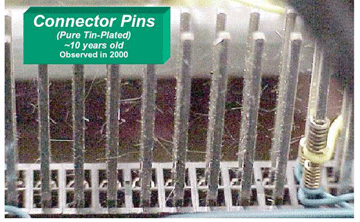Oct
2
The Good Tin Whiskers for Batteries
October 2, 2012 | 1 Comment
Dr. Grant Norton, professor in the School of Mechanical and Materials Engineering is leading researchers at Washington State University in developing a nanoneedle tin (Sn) anode material formed as “Tin Whiskers” for Lithium-ion batteries.
Elemental Sn is an attractive high-performance anode material because of its high theoretical specific capacity (992 mAh g-1) and high operating voltage along with the absence of solvent absorption.
Electrical engineers have been trying to minimize the problem of tin whiskers for over 60 years. The tiny needle-like structures growing on tin-plated electronics get up to ten millimeters long, and can cause short circuits.
Norton and postdoctoral researcher Uttara Sahaym were originally trying to mitigate tin whiskers, when they realized that they could actually be useful. The nanoneedles (or “whiskers”) used for the tin anode were grown directly on copper foil, using a standard electroplating process that’s commonly used in industry. This report suggests that the tin anode would be considerably cheaper to produce than traditional graphite anodes.
Norton and his team have reversed the problem into an opportunity. By gaining control of the whiskers growth the research has led to the creation of a tin battery anode, which Norton claims could triple the capacity of lithium-ion batteries. The claim is based on lab tests that also show the tin anode offers almost triple the energy storage capacity as its graphite counterparts. That is thanks to the plentiful surface area of the whiskers, which provides a ‘roost’ for a larger number of lithium ions.
Additionally, batteries incorporating the tin anode could recharge more quickly and many more times than existing lithium-ions batteries.
There are problems in other tin based anodes. Similar to silicon, tin experiences huge volumetric expansion and shrinkage on cycling, causing severe mechanical disintegration (such as cracking and pulverization) and thus shortened cycle life. A number of research groups are working on methods to prevent such life-limiting mechanical problems, such as the use of tin nanopillars layered between graphene sheets.
It is yet to be seen if the whisker anodes grown directly on copper foil avoid the expansion and shrinkage on cycling.
Norton and his colleagues are now in the process of building and testing batteries using their new anode. They have filed patents on the technology, and hope to have it commercialized within a year. Batteries incorporating the tin anode should be no different in shape or size than traditional batteries, so compatibility with devices shouldn’t be a problem.
It would be great if the adaptation of a naturally occurring problem would be a big improvement to a leading technology.
Comments
1 Comment so far




That is really interesting, You are an overly skilled blogger.
I’ve joined your rss feed and sit up for searching for more of your great post.
Also, I have shared your web site in my social networks